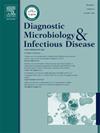Detection of Enterococcus faecalis and the red complex bacteria analyzed by the Checkerboard technique for DNA-DNA hybridization in endodontic infections: A systematic review and meta-analysis
IF 2.1
4区 医学
Q3 INFECTIOUS DISEASES
Diagnostic microbiology and infectious disease
Pub Date : 2024-12-09
DOI:10.1016/j.diagmicrobio.2024.116654
引用次数: 0
Abstract
Endodontic infections include conditions such as pulp necrosis, apical periodontitis, abscesses, granulomas, and periapical cysts. Detection of pathogenic microorganisms responsible for these diseases is essential for accurate diagnosis and future therapy. Enterococcus faecalis, Porphyromonas gingivalis, Tannerella forsythia, and Treponema denticola were analyzed qualitatively and quantitatively using the Checkerboard methodology for DNA-DNA hybridizations as a bacterial identification tool. Clinical investigations have shown a significant frequency of these microorganisms. The present systematic review and meta-analysis aimed to determine the prevalence of E. faecalis and red complex bacteria (RCB) (P. gingivalis, T. forsythia, and T. denticola) analyzed by the Checkerboard DNA-DNA hybridization technique in endodontic infections. This systematic literature review followed the Preferred Reporting Items for Systematic Reviews and Meta-analysis (PRISMA) guidelines—electronic databases: PubMed, Scopus, ScienceDirect, Web of Science, and Google Scholar. Statistical analysis was performed using STATA V.15 software. Seventeen articles were included, of which a total of 620 samples were evaluated. Five hundred sixty-seven samples were taken from infected root canals, 34 samples from periradicular tissues, and 27 samples from periapical abscesses of infected teeth. The prevalence of E. faecalis in endodontic infections in all studies was 74 %, of P. gingivalis was 63 %, of T. forsythia 46 %, and of T. denticola 58 %. The presence of bacteria such as E. faecalis reduces the efficiency of endodontic therapy and leads to recurring infections. It is recognized that "RCB" can be identified in endodontic lesions; however, they are not usually prominent. The DNA-DNA hybridization approach is critical for identifying bacteria and detecting difficult-to-culture microorganisms, making it a helpful and cost-effective tool for directing personalized endodontic treatments.
用DNA-DNA杂交棋盘格技术检测粪肠球菌和红色复合体细菌在牙髓感染中的应用:系统综述和荟萃分析。
牙髓感染包括牙髓坏死、根尖牙周炎、脓肿、肉芽肿和根尖周囊肿。检测导致这些疾病的病原微生物对于准确诊断和未来治疗至关重要。采用棋盘法对粪肠球菌、牙龈卟啉单胞菌、连翘Tannerella连翘菌和齿密螺旋体进行定性和定量分析,作为细菌鉴定工具。临床调查显示这些微生物的频率很高。本研究采用棋盘DNA-DNA杂交技术对粪肠球菌和红色复合体细菌(牙龈卟啉卟啉、连翘卟啉和齿状卟啉卟啉)在牙髓感染中的流行情况进行了系统回顾和荟萃分析。本系统文献综述遵循系统评价和荟萃分析(PRISMA)指南的首选报告项目-电子数据库:PubMed, Scopus, ScienceDirect, Web of Science和谷歌Scholar。采用STATA V.15软件进行统计分析。纳入17篇文章,共评估620个样本。感染根管标本567份,根周标本34份,根尖周脓肿标本27份。在所有研究中,粪肠球菌在牙髓感染中的患病率为74%,牙龈假单胞菌为63%,连翘假单胞菌为46%,牙齿假单胞菌为58%。粪肠杆菌等细菌的存在降低了牙髓治疗的效率,并导致复发性感染。目前认为,“RCB”可以在牙髓病变中被识别出来;然而,它们通常并不突出。DNA-DNA杂交方法对于鉴定细菌和检测难以培养的微生物至关重要,使其成为指导个性化牙髓治疗的有用且具有成本效益的工具。
本文章由计算机程序翻译,如有差异,请以英文原文为准。
求助全文
约1分钟内获得全文
求助全文
来源期刊
CiteScore
5.30
自引率
3.40%
发文量
149
审稿时长
56 days
期刊介绍:
Diagnostic Microbiology and Infectious Disease keeps you informed of the latest developments in clinical microbiology and the diagnosis and treatment of infectious diseases. Packed with rigorously peer-reviewed articles and studies in bacteriology, immunology, immunoserology, infectious diseases, mycology, parasitology, and virology, the journal examines new procedures, unusual cases, controversial issues, and important new literature. Diagnostic Microbiology and Infectious Disease distinguished independent editorial board, consisting of experts from many medical specialties, ensures you extensive and authoritative coverage.

 求助内容:
求助内容: 应助结果提醒方式:
应助结果提醒方式:


